The Arts on Stamps of the World — November 14
An Arts Fuse regular feature: the arts on stamps of the world.
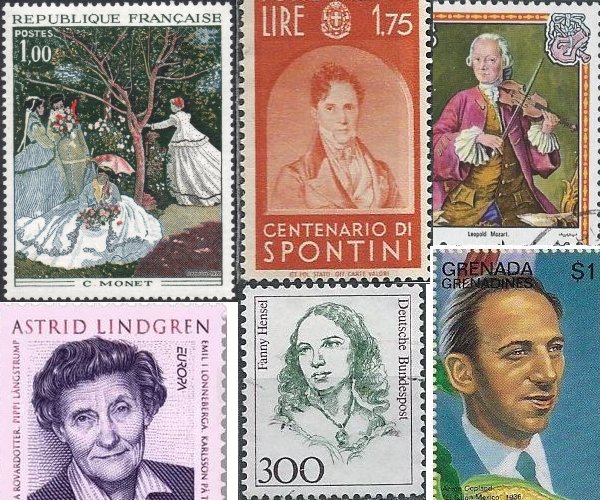
By Doug Briscoe
We lead off today with Claude Monet, Aaron Copland, and Pippi Longstocking creator Astrid Lindgren and will also visit with Mozart’s father, Mendelssohn’s sister, Veronica Lake, and Narciso Yepes, among numerous others.
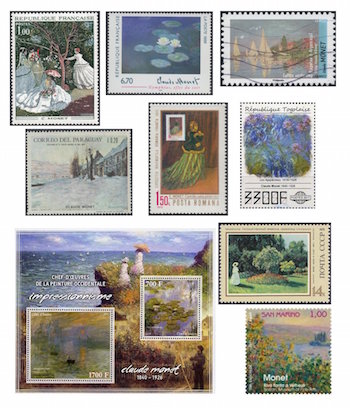
So we have the usual explosion of stamps for a famous painter in the case of today’s Claude Monet (November 1840 – 5 December 1926). Again, part of this profusion is due to the spate of admittedly often beautifully designed sheets from African and Pacific and Caribbean nations that earn much revenue from the sale of such stamps, but they are not really intended to be used as postage, although perfectly legal for that purpose. If, that is, they were printed by a recognized government, which oftentimes is not the case. (Rebel forces sometimes make these to finance their rebellion or to lend legitimacy to their opposition government.) Anyway, let’s begin with three stamps of France that require no disclaimer: Women in the Garden (1866-67), one of Monet’s very many pictures of water lilies, this one called Evening Effects or Waterlilies in Moonlight, and Regatta at Argentueil. From France we go far afield to Paraguay, Romania, and Togo for Lavacourt under Snow (c1878-81), The Woman in the Green Dress (Camille Doncieux) (1866), and Agapanthus (c1914-26). The minisheet from Côte d’Ivoire offers Impression, Sunrise (1872) and more of Monet’s beloved water lilies, while the background picture is Cliff Walk at Pourville (1882). To the right of the sheet we see, on a Russian stamp, Woman in a Garden (1867) and, finally, on one from San Marino, a painting that hangs in our own MFA: Flower Beds at Vétheuil (1881). Here’s a bonus, a painting I discovered in my online rambles, Turkeys.
I was surprised and disappointed that in the year 2000 the United States chose not to issue a stamp commemorating the centenary of the birth of Aaron Copland (1900 – December 2, 1990). This one comes from a stamp sheet issued by Grenada Grenadines in 1996.
Pippi Longstocking is only the most famous of the numerous children’s characters invented by Astrid Lindgren (14 November 1907 – 28 January 2002), a good many of whom can be seen on a set of ten Swedish stamps issued in 1987. I won’t name them all, but Pippi is at bottom center. Another Pippi stamp is next to one for the author herself, issued in 1996. Lindgren submitted a novel in a competition in 1944, finished second, and the next year won first place with Pippi Långstrump. That book has been translated into more than sixty languages. A study conducted earlier this year showed that Lindgren is the world’s 18th most translated author and the fourth among children’s writers (the first three were Enid Blyton, H. C. Andersen, and the Brothers Grimm). In 1978 a minor planet, 3204 Lindgren, was named for her, leading astrophysicist wags to dub it Asteroid Lindgren.
Austrian architect Johann Lukas von Hildebrandt (14 November 1668 – 16 November 1745) is represented on stamps only by one of his many distinguished buildings, but that one is a major tourist attraction, the Belvedere Palace in Vienna. Naturally these are mostly Austrian stamps, except for the one issued by the United Nations and a pair put out under German auspices when Austria was, ahem, part of Germany. As for Hildebrandt himself, he was born in Genoa (his mother was Italian) and studied in Rome, where he found favor with no less a figure than Prince Eugene of Savoy, for whom Hildebrandt built fortresses during his Italian campaigns. As of 1700 he was court engineer in Vienna, court architect in 1723. It was Eugene who commissioned both the Upper (1721-22) and Lower (1714-16) Belvedere Palaces. Hildebrandt was less favored by royalty than his rivals Johann Bernhard Fischer von Erlach and his son Joseph Emanuel, but got plenty of work from the aristocracy. His other prominent buildings include Schwarzenberg Palace and St. Peter’s Church in Vienna, Savoy Castle in Ráckeve, Hungary, and Schönborn Palace and the parish church in Göllersdorf.
It may be surprising that the close relatives of two great composers, Mozart’s father and Mendelssohn’s sister, should have the same birthday. Both were gifted composers in their own right.
Wolfgang’s father Leopold Mozart ( 1719 – 28 May 1787) has not been honored on stamps by Germany, where he was born, nor Austria, where he lived most of his life, but a set of Mozart stamps issued by the United Arab Emirates state of Ras al-Khaima includes one for Leopold, who also appears on a Monaco stamp, where he is seen playing the violin with his children.
Fanny Mendelssohn (1805 – 14 May 1847), sometimes known by her married name of Hensel, composed over 460 pieces of music, but very few of them, notably her Piano Trio and occasionally some songs or piano pieces, are heard nowadays. Several of the songs published as Felix’s Opp. 8 and 9 were actually composed by Fanny. Her death after a stroke in 1847 was devastating to Felix, who died of the same cause within six months. His powerful f-minor string quartet was written in her memory.
Opera composer Gaspare Spontini (1774 – 24 January 1851) has, to the best of my knowledge, been recognized only on stamps of his native Italy. His works were much admired in his day, but were rarely staged in the 20th century and remain so today, although his arias are commonly encountered on old recordings by famous singers. He was married to a niece of Sébastien Érard the instrument maker. While in Germany, where Spontini was Kapellmeister of the Berlin Hofoper, he met the 17-year-old Mendelssohn. I don’t know whether he met Mendelssohn’s older sister Fanny at that time. They might have been amused to learn that they shared a birthday.
Danish poet and playwright Adam Oehlenschläger (14 November 1779 – 20 January 1850) is credited with introducing Romanticism into Danish literature. He started jotting down verses when he was nine, and at twelve caught the attention of the Norwegian poet Edvard Storm, who took Oehlenschläger under his wing at the school where he was principal. The young man tried acting but apparently wasn’t very good at it and returned to poetry. He was good at that. After producing a number of fine pieces in that form, Oehlenschläger wrote his first play, the tragedy Hakon Jarl (which inspired a symphonic poem by Smetana). He traveled to Germany and met Goethe. While in that country he revised an earlier long fantasy poem, Aladdin, which gave us more music, the incidental music by Carl Nielsen and the choral finale of the massive Busoni piano concerto. Oehlenschläger went on to Paris, Switzerland, where he was the guest of Madame de Staël, and Rome before returning home. His seventieth birthday was marked with a grand celebration, and he died just two months later.
While Oehlenschläger brought Romanticism to Denmark, Croatian novelist August Šenoa (originally Schönoa; 14 November 1838 – 13 December 1881) helped bridge the gap between Romanticism and Realism in Croatian literature. He is also the first Croatian to have written historical novels. A common perception among the Croats is that Šenoa essentially created a reading public in the region with his easy and popular style. He was also responsible for the lyrics to the patriotic song “Živila Hrvatska” (“Long live Croatia”), with music by Ivan Zajc. Following an earthquake in Zagreb in 1880, Šenoa fell victim to disease and expired the next year.
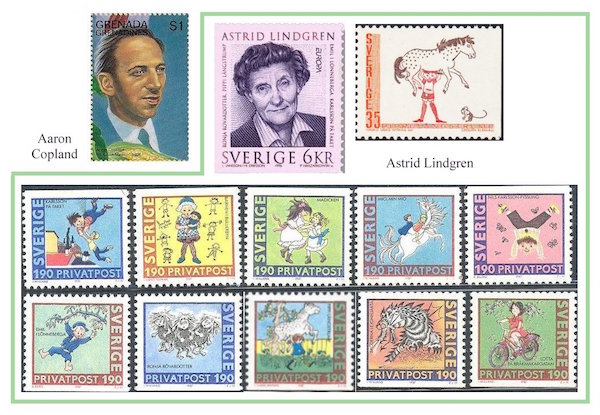
The best known work of Australian author who went by the pseudonym of Steele Rudd (14 November 1868 – 11 October 1935) was the volume of stories On Our Selection, and it is that work that is referred to on the stamp. “Selection” here refers to land claims made under legislation similar to the United States Homestead Act. Born Arthur Hoey Davis in Queensland, he left school before he was twelve. The first writing he did was articles about rowing, of which he was an enthusiast, for a weekly paper. In 1895 he submitted the first of the “Selection” sketches to the Australian magazine The Bulletin. The whole series was published in book form in 1899. This was such a success that Davis was able to retire and bring out a periodical called Rudd’s Magazine, which he kept afloat for four years. A 1920 film and a long-lived radio series, Dad and Dave (1932-52), made the characters into cultural icons.
We move from Australian writer Rudd to Polish modernist poet Leopold Staff (November 14, 1878 – May 31, 1957). (Thy Rudd and thy Staff, they comfort me.) He was born in Lwów, studied law and philosophy there, and turned thirty in the year Poland’s independence was restored. A proponent of Nietzsche, Staff in his poetry reflected the philosophy of the great German thinker as well as the tenets of the Franciscans and paradoxes in Christianity. He became highly influential in his own right between the wars, serving as early as 1918 as the inspiration for the experimental literary group Skamander. He was vice-president of the Polish Academy of Literature, received honorary doctorates from universities in Warsaw and Kraków, and was nominated for the Nobel Prize.
The painter Louis Marcoussis also came from Poland, though he lived much of his life in France and eventually became a French citizen. Sources conflict about his birth date and place, but German language Wikipedia specifically cites November 14, 1878 and Warsaw (others say Lódz). His name at birth was Ludwik Kazimierz Władysław Markus, and his family were Jews who had converted to Catholicism. None of his paintings was shown until 1905, by which time he had already relocated to Paris, but in the years to come there would be many more exhibitions. All the same, the first solo show didn’t take place until 1925, and in the meantime he earned his bread with cartoons and illustration. He got to know many of the great names in the arts—Braque, Degas, Picasso—and it was Apollinaire who suggested the name Marcoussis, taken from a village outside Paris. Cubism succeeded Impressionism in Marcoussis’s output. He worked with Joan Miró in the late 30s and moved to Vichy right after the occupation. There he died on 22 October 1941.
Another artist of Polish-Jewish descent who earned a living with cartooning was American sculptor William Steig (November 14, 1907 – October 3, 2003), who, later in his life, became a writer of children’s books. It is for the best known of these, Shrek! (1990), or rather the subsequent films, that a stamp exists. Steig, born in Brooklyn, was the child of immigrants from Austria. He was only in his early twenties when he started doing cartoons and illustrations for The New Yorker, eventually creating over 2500 drawings and 117 covers. He was known in some circles as the King of Cartoons. By contrast, he was 61 when he began writing children’s books. The first of his four wives was Margaret Mead’s sister Elizabeth (1909-1983). One of their children was the late jazz flutist Jeremy Steig (1942-2016).
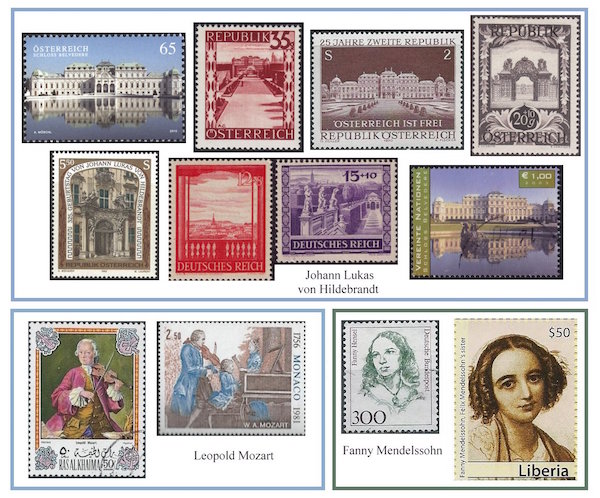
Although shown on this Austrian stamp as Carmen with Rudolf Schock, the American mezzo Jean Madeira (1918 – July 10, 1972) was associated more with the works of Wagner and Richard Strauss. She was born in Illinois and studied at Juilliard, going on to sing at the Met some 300 times between 1948 and 1971. She left numerous recordings.
As a youth, the Faroese painter Hans Hansen (November 14, 1920 – March 8, 1970) went to sea as a fisherman. Later he studied painting and, living in Iceland during the war, was further stimulated in that pursuit by Johannes Kjarval. Hansen continued his studies well into his 30s in Copenhagen and Paris. His work was mostly inspired by the sights of his native village. In 1998 a set of four Faroese postage stamps showing his works was issued: the simple titles are The Heath (1966), Village (1965), Man (1968), and Self-Portrait (1968).
American actress Veronica Lake (November 14, 1922 – July 7, 1973) was born Constance Frances Marie Ockelman in Brooklyn. Her father was killed in an industrial explosion when she was 10. She grew up in Miami and Beverly Hills. Her trademark look, hair falling over the right side of her face, came about inadvertently during the filming of I Wanted Wings (1940). She acted opposite Alan Ladd in This Gun for Hire (1942) and three other movies. She was famously difficult to work with, with alcoholism exacerbating the situation, and Raymond Chandler, who wrote the screenplay for The Blue Dahlia (1946), called her “Moronica Lake”. It was in that same year that she earned her pilot’s license. She left Hollywood for New York in 1951 to work in theater and television. A highlight of these later years was her much acclaimed performance as Blanche DuBois in a revival of A Streetcar Named Desire in the UK.
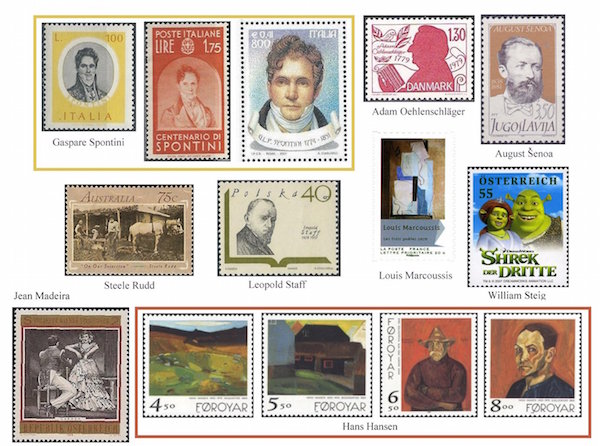
Spanish guitarist Narciso Yepes (14 November 1927 – 3 May 1997) was born in Murcia and received his first guitar at the age of four. For three days each week his father would take him on a donkey a distance of five miles for lessons. At 13, he entered the Valencia Conservatory. At 20, he made his début in Madrid, playing the Concierto de Aranjuez by Joaquín Rodrigo. This concert established Yepes’s bona fides, and he went on to make two recordings of the concerto with Ataúlfo Argenta, who had also conducted that Madrid performance. (Both Rodrigo and Argenta have birthdays next week). Yepes went on to study interpretation with George Enescu and Walter Gieseking. He wrote the music for a number of films and played on the soundtrack of René Clément’s Forbidden Games (Jeux interdits, 1952). He also appeared in a 1967 film version of El amor brujo. He invented a ten-string guitar with the instrument maker José Ramírez III and was the first to record the complete lute works of Bach on period instruments.
English sculptor and printmaker Dame Elisabeth Frink (14 November 1930 – 18 April 1993) was nine years old when her father was one of those successfully evacuated from Dunkirk. This and her proximity to the war (she lived in Suffolk) may have been the source of her sculptures of falling and flying men. Men, animals, especially horses, and religious iconography were recurring themes, rarely women. An exception is Walking Madonna. She was honored on a British stamp in 1996.
Although he acted in only two vehicles in the series, English actor of Irish descent Paul McGann (born 14 November 1959) qualifies as the eighth Doctor Who. The first of these appearances was in the Doctor Who television film of 1996, and then, many years later, he reprised the role for a mini-episode, The Night of the Doctor (2013). Born in Liverpool, McGann’s breakthrough came in the 1986 TV serial The Monocled Mutineer. He was set to portray the lead character in the Sharpe series (set during the Napoleonic Wars, after novels by Bernard Cornwell) when he injured his knee and had to drop out; he was replaced by Sean Bean. McGann also played Lieutenant William Bush in the Hornblower TV series that ran from 1998 to 2003.
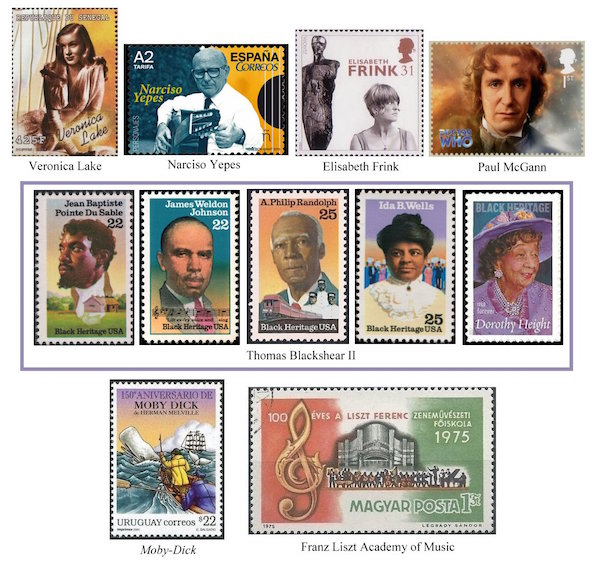
African-American artist Thomas Blackshear II (born November 14, 1955) has provided many paintings for Evangelical churches, besides working as a sculptor and designer of ornaments. He was born in Waco, grew up in Atlanta, and studied art in Chicago. He has designed five stamps for the United States Postal Service’s long-running Black Heritage series, four of them between 1987 and 1990, and we present them all. They are for Jean Baptiste Point du Sable, the earliest recorded resident of the settlement that eventually became Chicago; James Weldon Johnson, author and songwriter; Asa Philip Randolph, civil rights and labor leader; and Ida B. Wells, journalist. The fifth stamp (of those I mentioned) just came out this year. Co-designed with Lateef Mangum, it honors educator and activist Dorothy Height.
Additionally, Blackshear has designed a number of other U.S. postage stamps, many of which we’ve already seen in these pages: stamps for James Cagney, Jelly Roll Morton, and Thelonious Monk, and for the movies The Wizard of Oz, Gone with the Wind, and Stagecoach.
On this date in 1851, Herman Melville’s Moby-Dick was published in the USA. We see a stamp from, of all places, Uruguay.
The Franz Liszt Academy of Music is a concert hall and music conservatory in Budapest, Hungary, founded on November 14, 1875. The stamp was issued for the centenary.
A graduate of the University of Massachusetts with a B.A. in English, Doug Briscoe worked in Boston classical music radio, at WCRB, WGBH, and WBUR, for about 25 years, beginning in 1977. He has the curious distinction of having succeeded Robert J. Lurtsema twice, first as host of WGBH’s weekday morning classical music program in 1993, then as host of the weekend program when Robert J.’s health failed in 2000. Doug also wrote liner notes for several of the late Gunther Schuller’s GM Recordings releases as well as program notes for the Boston Classical Orchestra. For the past few years he’s been posting a Facebook “blog” of classical music on stamps of the world, which has now been expanded to encompass all the arts for The Arts Fuse.

